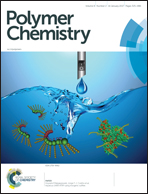Aqueous SARA ATRP using inorganic sulfites†
Abstract
Aqueous supplemental activator and reducing agent atom transfer radical polymerization (SARA ATRP) using inorganic sulfites was successfully carried out for the first time. Under optimized conditions, a well-controlled poly[oligo(ethylene oxide) methyl ether acrylate] (POEOA) was obtained with <30 ppm of a soluble copper catalyst using a tris(2-pyridylmethyl)amine (TPMA) ligand in the presence of an excess of halide salts (e.g. NaCl). Inorganic sulfites (e.g. Na2S2O4) were continuously fed into the reaction mixture. The mechanistic studies proved that these salts can activate alkyl halides directly and regenerate the activator complex. The effects of the feeding rate of the SARA agent (inorganic sulfites), the ligand and its concentration, halide salt and its concentration, sulfite used, and copper concentration, were systematically studied to afford fast polymerization rates while maintaining the control over polymerization. The kinetic data showed linear first-order kinetics, linear evolution of molecular weights with conversion, and polymers with narrow molecular weight distributions (Đ ∼ 1.2) during polymerization even at relatively high monomer conversions (∼80%). “One-pot” chain extension and “one-pot” block copolymerization experiments proved the high chain-end functionality. The polymerization could be directly regulated by starting or stopping the continuous feeding of the SARA agent. Under biologically relevant conditions, the aqueous SARA ATRP using inorganic sulfites was used to synthesize a well-defined protein–polymer hybrid by grafting of P(OEOA480) from BSA-O-[iBBr]30.



 Please wait while we load your content...
Please wait while we load your content...